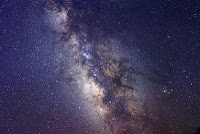
Next time you’re out under a clear, dark sky at night, look up and pick out a star at random. Chances are, nobody knew until 15 years ago how far away that star is. Now, thanks to the European Space Agency’s Hipparcos mission, we know.
Your randomly chosen star is probably somewhere between 100 and 1000 light-years away, although there’s about a 15% chance that it’s closer, and about a 10% chance that it’s farther. If your star is one of that nearest 15%, then its distance was probably known, to an accuracy of 50% or better, before Hipparcos. Otherwise, astronomers could have given you no better than a rough estimate of your star’s distance.
Direct measurements of star distances come from the method of triangulation, or parallax: Look at the star from two different directions, and measure its angular shift as you switch viewing locations. It’s the same principle as two-eyed vision, except that in the case of stars, the two viewing locations are on opposite sides of earth’s orbit around the sun—300 million kilometers apart.
Despite this enormous baseline, the angular shifts are miniscule, even for the nearest stars. And for stars beyond 100 light-years, the angles are too small to measure with any accuracy through earth’s blurry atmosphere. So in 1989 the ESA launched the Hipparcos satellite, carrying a special-purpose telescope dedicated to making accurate measurements of the positions of 100,000 stars. By repeating the measurements over a three-year period, the instrument determined not only the parallax shifts but also the steady motions of the stars as they gradually drift across our galaxy. The catalog of results, published in 1997, gives accurate distances and motions for all but a handful of the naked-eye stars, and many, many more.
You can now read about the Hipparcos mission in a new book by Michael Perryman: The Making of History’s Greatest Star Map. Perryman was Coordinating Scientist for the Hipparcos mission, and he does a masterful job at conveying what an immense undertaking it was. Hundreds of scientists spent many years of their careers on Hipparcos, while some of Europe’s most advanced industries fabricated the satellite and its unique optical system. The story also includes high drama, thanks to the failure of the booster rocket that was to put the satellite into its final orbit. That the scientists were able to recover from this disaster and still surpass all the mission’s goals was nothing short of miraculous.
Unfortunately, Perryman’s book has several shortcomings. He tries to do too much, telling not only the story of the Hipparcos mission but also the whole history of astronomy since ancient times—in fewer than 300 pages. Indeed, the main intent of this book is apparently to establish the place of Hipparcos in history, and to properly credit several dozen of the principal scientists for their respective roles. Educating the reader is secondary, and although the book tries to be accessible to non-astronomers (and to wow them with vague superlatives), I fear that most would be overwhelmed by the enormous number of technical details so superficially explained. I learned quite a bit from the book, but I’m already a professional physicist who teaches introductory astronomy. For my own part, I was disappointed that the book didn’t adequately explain how the Hipparcos optical system worked, or even point to a reference where I could learn more. I still have no idea why the system’s limiting resolution was about a thousandth of an arc-second, or how this relates to the diameter of its main mirror (30 centimeters).
Still, the inadequacies of the book shouldn’t detract from the importance of the Hipparcos mission. Virtually every subfield of astronomy now rests upon a firmer foundation, thanks to Hipparcos.
As an American, I can’t help but notice the differences between Hipparcos and the many equally impressive science missions carried out by NASA. Hipparcos produced no pretty pictures, and made no sudden discoveries. You can’t convey its importance in a ten-second sound-bite. It was designed, built, launched, operated, and funded by people who were focused not on short-term payoffs but on the long-term advancement of science. Such a mission would never have been supported by NASA, an agency that is forced to put glamor ahead of science because its budget is continually threatened by the whims of politicians. Of course, an advantage of the American system is that NASA has become very good at making its results accessible to the general public.
Ironically, it may not be long before the importance of the Hipparcos mission is merely historical. Encouraged by its success and the progress of technology over the last two decades, the ESA is now preparing a successor mission called Gaia, scheduled for launch in late 2012. If all goes as planned, Gaia will measure the positions of a billion stars, with an accuracy a hundred times greater than that of Hipparcos. Its completed three-dimensional star map will stretch across most of the Milky Way galaxy, far beyond the most distant naked-eye stars. Gaia will also discover thousands of planets orbiting distant stars, as well as tens of thousands of asteroids within our solar system. It will gather data over a period of five years, and its results will be published by 2020.



